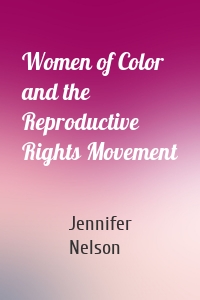Jennifer Nelson
2 кн.
More Than Medicine
In 1948, the Constitution of the World Health Organization declared, “Health is a state of complete physical, mental and social well-being and not merely the absence of disease or infirmity.” Yet this idea was not predominant in the United States immediately after World War II, especially when it came to women’s reproductive health. Both legal and medical institutions—and the male legislators and physicians who populated those...
| Автор | Jennifer Nelson |
Women of Color and the Reproductive...
While most people believe that the movement to secure voluntary reproductive control for women centered solely on abortion rights, for many women abortion was not the only, or even primary, focus.Jennifer Nelson tells the story of the feminist struggle for legal abortion and reproductive rights in the 1960s, 1970s, and early 1980s through the particular contributions of women of color. She explores the relationship between second-wave feminists, who were concerned with a woman's right to...
| Автор | Jennifer Nelson |



